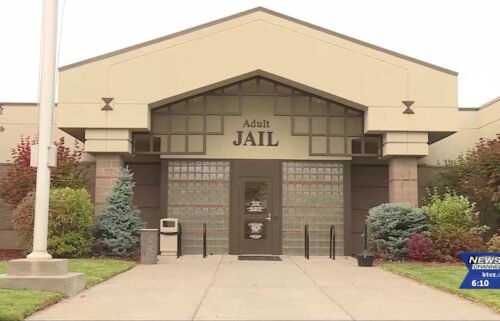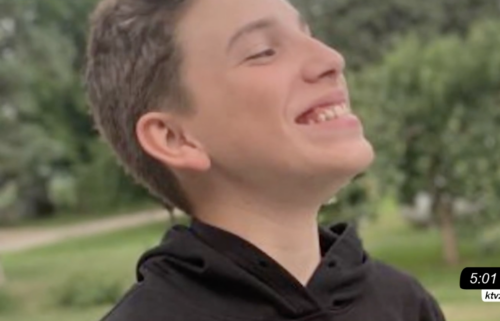VIPs visit Bend, sign sage grouse habitat preservation

U.S. Interior Secretary Sally Jewell joined Oregon Gov. Kate Brown and other dignitaries in Bend Friday afternoon to celebrate landmark agreements to let Central and Eastern Oregon landowners enroll their property in a voluntary sage grouse habitat conservation program.
U.S. Department of Agriculture Deputy Under Secretary Ann Mills also was on hand for the signing ceremony, held at the Deschutes National Forest headquarters in Bend.
“We have an unprecedented effort going on around the sage brush-steppe ecosystem that’s really been fueled by the potential listing by the sage grouse on the endangered species list,” Jewell said.
All were there to embrace a program offered to landowners in all eight Eastern and Central Oregon counties with greater sage-grouse habitat, an effort that could protect up to about 2.3 million acres of sagebrush-steppe habitat.
“While it’s absolutely critical to preserving the sage grouse, we obviously want to avoid an endangered species listing,” said Gov. Brown. “I think the key is to avoid the heavy hand of (federal) regulation.”
Keeping the sage grouse off the endangered species list helps Central Oregon ranchers.
“They give us the chance to proactively engage on the sage grouse issue,” said John O’Keeffe, a Lake County rancher and president-elect of the Oregon Cattlemen’s Association.
Instead of more limits and regulation, they are looking at collaboration on all levels.
“Partnerships work when you bring together private land owners, you bring together NGOs (non-governmental organizations), and state and federal agencies come up with a set of solutions that are enduring,” Mills said.
The key is to balance the need to help conserve the sage grouse, while supporting ranchers.
“How can we, as the federal government, provide assurances that if people take these conservation measures, they will continue to be able to pursue their livelihoods on these lands, just as they have before,” Jewell said. “So, nothing like this, ever, in the history of the United States with what’s going on right now.”
Unprecedented measures that are making Oregon a role model around the country.
“I think this is a great model, and I think we’re going to call it the Oregon Way and I think we’re going to encourage our other partners, our other Western states to move into this same direction,” Brown said.
A model that helps raise the next generation of Central Oregon ranchers.
“Those new generations, they have the opportunity that I had to grow up on a ranch and provide America with some of the best food on Earth,” O’Keeffe said.
Jewell and the governor praised the spirit of cooperation the agreements represent, and expressed their hopes that both sage grouse and family ranches would thrive.
O’Keefe said the agreements would help his family ranch continue into the fourth and fifth generations.
The agreements are the latest in a series announced by the Obama administration as the Sept. 30 deadline approaches for deciding whether to propose the greater sage grouse for Endangered Species Act protection.
Landowners who participate receive assurances that they will not face additional regulatory requirements if the bird is protected under the ESA — something with added restrictions they all hope to avoid.
“These voluntary agreements establish a collaborative partnership to ensure the conservation of the greater sage-grouse and sustain working western rangelands,” Jewell said.
“The agreements in Oregon are more evidence that we can work together to provide regulatory certainty for ranchers and other westerners who rely on sagebrush habitat for their livelihoods, and also take important steps to protect the hundreds of species that rely on these landscapes.”
“These agreements are essential to the continued health of the sagebrush ecosystem and the livelihood of ranchers,” Brown said. “By working together, the state, local districts, ranchers and the Fish and Wildlife Service have devised a plan that advances both the principles of conservation and the local economy.”
“Over the past five years, USDA has worked closely with partners and landowners to restore more than 4.4 million acres of sage-grouse habitat across the West, demonstrating the real impact that voluntary, collaborative conservation on private lands can have on a landscape scale,” Mills said.
“These voluntary practices have a proven track record, and today ‘s announcement will go a long way towards advancing our shared vision of healthy ranges and a healthy rural economy.”
Greater regulatory certainty can be provided in at least two ways; through Candidate Conservation Agreements with Assurances and through agreements with the USDA’s Natural Resources Conservation Service Sage Grouse Initiative.
Under these types of agreements, landowners and permittees voluntarily agree to manage their lands to remove or reduce threats to species.
Landowners, in return, receive predictability from the U.S. Fish and Wildlife Service that no additional conservation measures will be required or new restrictions imposed if the species becomes listed, so long as the agreements are being properly implemented.
The goal of the programs is to encourage immediate benefits for a species while providing the landowner with the ability to plan for the future.
The Oregon Multi-County CCAAs cover 2,312,673 acres, and the Department of State Lands CCAA includes 633,000 acres.
In combination with the Harney County Soil and Water Conservation District CCAA finalized in 2014, more than 4 million acres of privately owned lands now qualify for inclusion under these conservation agreements.
All BLM rangelands in Oregon are covered in parallel conservation agreements such that nearly all greater sage-grouse habitat on private, state, and federal land in Oregon is eligible to be covered under conservation agreements.
In Oregon, USDA has invested $18.4 million through SGI in on-the-ground restoration since 2010, helping more than 100 ranchers remove conifers from 200,000 acres of key nesting, brood-rearing and wintering habitats, addressing 68 percent of the conifer threat to Oregon’s sage-grouse population on priority private land.
These efforts not only benefit the sage-grouse, officials said, but also improve the forage available on grazing lands.
Since the Harney County Soil and Water Conservation District entered into its CCAA with the Service last May , it has enrolled over 53 landowners with more than 320,000 acres. Numerous ranchers are also ready to enroll under these new CCAAs.
Landowners and cattle producers who enroll will develop site-specific plans that address threats to sage-grouse and maintain or improve habitat.
The major threats in Oregon are wildfire and a resulting increase of exotic grasses and juniper encroachment.
All participating enrollees will agree to maintain contiguous habitat and avoid further fragmentation. Other activities that may be included in the plans are juniper removal, invasive grass and weed control, and marking fences known to be a collision hazard for sage-grouse.
Each CCAA was developed through locally driven efforts with a steering committee that included private landowners, livestock associations and stock growers, watershed councils, Soil and Water Conservation Districts, the U.S. Fish and Wildlife Service, the Natural Resources Conservation Service, County Courts, Oregon Department of Fish and Wildlife, Bureau of Land Management, Oregon State University Extension, The Nature Conservancy, Oregon Department of State Lands, and Native American tribes.
Friday ‘s announcement builds upon partnerships across the West to conserve sage-grouse habitat. In addition to the more than 1,100 ranchers partnering with USDA to deliver sustainable ranching measures on over 4.4 million acres through SGI, several innovative conservation agreements with landowners are focusing on providing net conservation gain while offsetting unavoidable impacts.
On Thursday,, the Interior Department announced an agreement with Barrick Gold of North America and The Nature Conservancy to provide credit for greater sage-grouse habitat improvements in Nevada while continuing to support gold mining in the state.
In Wyoming last week, the Interior Department joined Governor Matt Mead to announce the launch of the nation’s first conservation bank for greater sage-grouse .
Greater sage-grouse once occupied more than 290 million acres of sagebrush in the West, but the bird, known for its flamboyant mating ritual at sites called leks, has lost more than half of its habitat due to growing threats from rangeland fire, invasive species and development.
The deteriorating health of Western sagebrush landscapes has sparked an unprecedented and proactive partnership across 11 states to conserve the uniquely American habitat that supports iconic wildlife, outdoor recreation, ranching and other traditional land uses, the agency said.
More information on the greater sage-grouse and the ongoing, collaborative work to conserve the sagebrush landscape is available at: http://www.fws.gov/greatersagegrouse/ .



